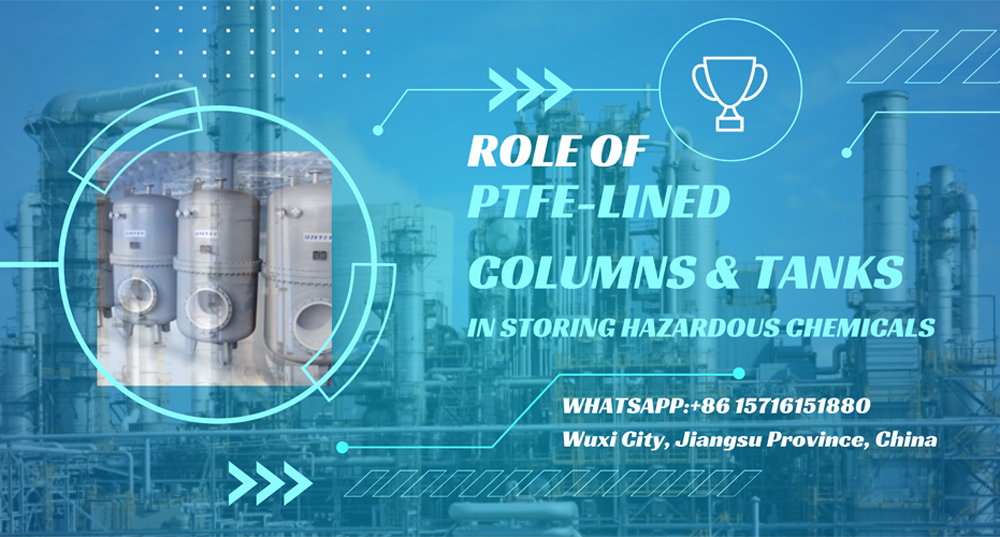
Storing hazardous chemicals safely and efficiently poses a significant challenge for many industries, from pharmaceuticals and petrochemicals to food processing and beyond. These substances often require specialized containment solutions to prevent leaks, spills, and the potentially catastrophic consequences they could cause. Among the many innovations in this field, PTFE-lined columns and tanks have emerged as a premier choice due to their exceptional chemical resistance and durability.
Polytetrafluoroethylene (PTFE), a synthetic fluoropolymer of tetrafluoroethylene, is renowned for its outstanding properties. It is non-reactive, which makes it an ideal lining material for containers holding aggressive chemicals. PTFE-lined columns and tanks are not only resistant to a wide range of temperatures but also demonstrate an unparalleled ability to withstand corrosive environments that would degrade other materials.
The application of PTFE lining in columns and tanks enhances safety by providing a robust barrier that minimizes the risk of contamination and chemical reactions. This protection is vital in industries where the purity of chemicals is paramount and where exposure to even trace amounts of reactive substances can be hazardous. Furthermore, the durability of PTFE ensures that these storage solutions are cost-effective over the long term, as they require less maintenance and can survive harsh conditions without frequent replacement.
Polytetrafluoroethylene (PTFE) is a synthetic fluoropolymer that has revolutionized the way industries handle and store hazardous chemicals. Its characteristics make it an indispensable material in the production of lined columns and tanks. Below is a detailed exploration of the properties and advantages of PTFE lining, particularly in the context of storing hazardous chemicals.
PTFE is highly resistant to a vast array of chemicals, making it almost universally applicable in the chemical industry. Its resistance extends to aggressive acids, bases, and solvents, including hydrochloric acid, sulfuric acid, sodium hydroxide, and acetone. This resistance is due to PTFE's unique molecular structure, where the carbon atoms are completely surrounded by fluorine atoms, creating a protective barrier that most chemicals cannot penetrate.
One of the standout features of PTFE is its ability to withstand extreme temperatures without losing its integrity. It remains stable across a wide temperature range from -200°C to +260°C (-328°F to +500°F). This property is crucial for processes that involve high-temperature operations or storage in fluctuating climatic conditions. Tanks and columns lined with PTFE can safely contain chemicals that need to be processed or stored at high temperatures, significantly reducing the risk of accidents and equipment failure.
PTFE has a remarkably low coefficient of friction, which gives it a non-stick surface. This characteristic is particularly beneficial in the storage and processing of viscous or sticky substances. The non-stick nature ensures that residues do not adhere to the walls of tanks or columns, facilitating easier cleaning and reducing cross-contamination risks between batches. It also minimizes product loss, which can be a significant cost-saving measure over time.
Due to its high purity, PTFE does not contaminate the chemicals it comes into contact with. This feature is essential for industries like pharmaceuticals and food processing, where maintaining the purity of chemicals is mandatory. The non-reactive nature of PTFE ensures that it does not react with the stored substances, thereby preserving their chemical integrity and preventing hazardous side reactions.
Despite its non-reactive and soft surface characteristics, PTFE is mechanically strong and can withstand significant physical stress. It maintains its form under compression and tensile forces, which makes it suitable for high-pressure applications. The durability of PTFE ensures that columns and tanks lined with this material have a long operational life, even in harsh industrial environments that can cause wear and tear on less robust materials.
The use of PTFE-lined columns and tanks provides several key benefits that make them exceptionally well-suited for storing hazardous chemicals. These advantages are not only pivotal in maintaining safety but also in enhancing operational efficiency and ensuring the integrity of the stored substances. Below, we delve into these benefits in detail.
The primary benefit of using PTFE linings in columns and tanks is their superior chemical compatibility. PTFE does not react with most chemicals, which means it can safely contain a wide variety of hazardous substances without risk of degradation. This includes extremely corrosive acids like nitric acid, sulfuric acid, and hydrofluoric acid, which can quickly erode other materials. The inert nature of PTFE ensures that these substances remain pure and uncontaminated, crucial for maintaining quality in processes such as pharmaceutical manufacturing and specialty chemical production.
Safety is a paramount concern when dealing with hazardous chemicals, and PTFE linings significantly reduce the risk of leaks and spills. The seamless nature of PTFE linings creates a robust barrier that prevents chemicals from penetrating or degrading the tank walls. This containment capability is critical in preventing environmental contamination and exposure to personnel, which can lead to severe health risks and regulatory penalties. Furthermore, PTFE's non-flammability enhances safety in environments where fire hazards are a concern.
PTFE linings are known for their durability and resistance to wear. This translates to longer life spans for tanks and columns, reducing the frequency and costs of replacements. Unlike other materials that may require frequent maintenance due to corrosion or degradation, PTFE-lined equipment remains functional and reliable over extended periods, even under harsh conditions. This durability also means that operations can continue without unexpected downtime, enhancing overall productivity.
While the initial cost of PTFE-lined columns and tanks can be higher than those made with less durable materials, the long-term savings are significant. The reduced need for maintenance, coupled with the extended lifespan of the equipment, results in lower total cost of ownership. Additionally, the efficiency of PTFE in preventing product loss by minimizing residue and contamination helps in saving costs associated with wasted materials and additional cleaning.
Using PTFE-lined columns and tanks contributes to a more sustainable approach to chemical storage. By preventing leaks and spills, these linings help protect the surrounding environment from potentially harmful exposures. Additionally, the long lifespan and reduced need for replacement parts mean less waste and resource consumption. For industries looking to enhance their environmental credentials, investing in PTFE-lined solutions is a step in the right direction.
To demonstrate the practical applications of PTFE-lined columns and tanks, we explore several case studies that highlight how these solutions are implemented in various industries. These examples will help illustrate the diverse uses and benefits of PTFE lining in real-world scenarios.
Situation:
A pharmaceutical company needed to store a highly reactive and sensitive ingredient used in the production of medications. The chemical was known to react with traditional storage materials, leading to contamination and loss of efficacy in the medication.
Solution:
The company implemented PTFE-lined tanks to store the reactive ingredient. The PTFE lining provided a non-reactive surface that prevented the chemical from interacting with the tank walls, ensuring the purity and quality of the pharmaceutical ingredient.
Outcome:
The switch to PTFE-lined tanks resulted in a significant decrease in contamination incidents. The company noted improved stability in their medication's efficacy and a reduction in raw material waste. Additionally, the PTFE tanks required less frequent cleaning and maintenance, leading to operational cost savings.
Situation:
A petrochemical plant was facing issues with corrosion and wear in their storage tanks, which stored a variety of aggressive solvents used in the production of plastics and synthetic rubber. The corrosion was causing frequent leaks and costly downtime for repairs.
Solution:
The plant replaced their conventional tanks with PTFE-lined columns and tanks. The chemical resistance of PTFE ensured that even the most aggressive solvents could be stored without affecting the tank's integrity.
Outcome:
The installation of PTFE-lined tanks dramatically reduced the incidence of leaks and extended the service life of the tanks. The plant was able to operate more continuously without unscheduled interruptions, enhancing productivity and reducing repair and replacement costs.
Proper installation and maintenance are critical for maximizing the benefits of PTFE-lined columns and tanks. This section outlines the key considerations and best practices to ensure these systems operate effectively and last longer.
1.Pre-Installation Inspection:
Before installing PTFE-lined tanks or columns, a thorough inspection is necessary to ensure there are no defects in the lining. Even small imperfections can lead to major issues in hazardous chemical storage. Ensure the lining is intact and free from cracks, bubbles, and pinholes.
2.Handling and Transportation:
PTFE-lined equipment requires careful handling to prevent damage. Use appropriate lifting techniques and equipment to avoid putting stress on the lining. Ensure that the tanks or columns are transported in a way that prevents them from tipping over or being struck by other objects.
3.Installation Environment:
The area where the tanks or columns will be installed should be clean, dry, and free from any debris that could damage the PTFE lining. Additionally, consider the ambient temperature and chemical exposure, as extreme conditions can affect the integrity of the lining.
4.Sealing and Connections:
When connecting PTFE-lined tanks or columns to the rest of the system, ensure that all fittings and seals are compatible with PTFE. Use gaskets and seals that are designed to work with PTFE to prevent leaks and maintain the chemical resistance properties.
5.Support and Anchoring:
Proper support and anchoring are crucial to prevent stress and deformation of PTFE-lined tanks and columns. Ensure that the support structure is designed to hold the weight and that it does not transmit vibrations or other forces that could damage the lining.
1.Regular Inspections:
Schedule regular inspections to check for signs of wear, corrosion, or damage to the PTFE lining. Look for discoloration, swelling, or cracks in the lining, as these can be indicators of chemical attack or mechanical damage.
2.Cleaning Procedures:
Use non-abrasive cleaning methods to avoid damaging the PTFE lining. Ensure that the cleaning chemicals are compatible with PTFE. Regular cleaning helps prevent buildup of residues that could affect the tank's performance.
3.Preventive Maintenance:
Implement a preventive maintenance schedule to replace worn seals and gaskets before they fail. Check all connections and fittings for signs of leakage or wear and make necessary adjustments.
4.Temperature and Pressure Monitoring:
Continuously monitor the temperature and pressure within the PTFE-lined tanks and columns. Exceeding the recommended limits can compromise the lining and lead to failure. Use appropriate sensors and alarms to alert operators of any unsafe conditions.
5.Documentation and Records:
Keep detailed records of all maintenance activities, inspections, and repairs. This documentation can help identify patterns that may indicate underlying issues and can be useful for warranty claims or regulatory compliance.
The use of PTFE-lined columns and tanks has become a cornerstone in the safe and efficient storage of hazardous chemicals across various industries. This technology leverages the unique properties of PTFE, including its exceptional chemical resistance, thermal stability, and non-reactive nature, to provide unparalleled safety and reliability in chemical handling and storage.
From pharmaceuticals to petrochemicals and specialty chemicals, the case studies highlighted demonstrate the versatility and effectiveness of PTFE linings in protecting both the stored substances and the environment. These applications show that whether in reducing contamination, preventing equipment failure, or enhancing operational efficiency, PTFE-lined solutions offer significant advantages.
Feel free to leave your message on our board. If you're looking to inquire about prices or place an order, this is the right place! Let us know the details of your needs, and our team will get back to you with a personalized quote as quickly as possible. We're here to ensure your experience is seamless and satisfactory. Share your requirements or ask any questions you might have - we're eager to assist and look forward to doing business with you!
Name:Tim
Phone:+86-15716151880
Email:[email protected]
Company:BEANT
Address:No. 28, Luoshen Road, Luoshe Town, Huishan District, Wuxi City, Jiangsu Province
